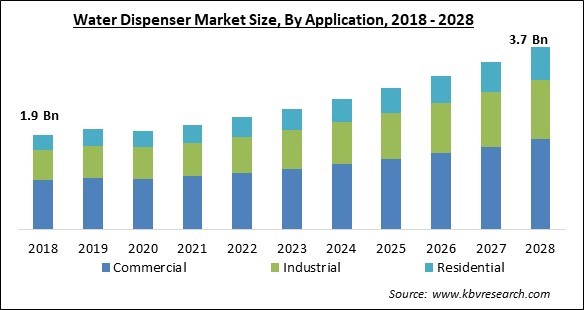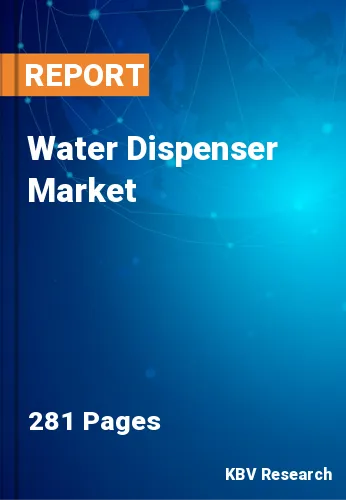The Global Water Dispenser Market size is expected to reach $3.7 billion by 2028, rising at a market growth of 8.5% CAGR during the forecast period.
Connecting to existing water supply, a water dispenser system provides a limitless supply of purified, safe drinking water to any office. Users can fill their glass by placing a cup, bottle, or jug under the nozzle and then pressing a lever or button. They have a refrigerator that chills drinking water to a cold or ice-cold temperature before delivering it. Heating, purification, and even liquid carbonation are included in the functions, which go beyond cooling.

The introduction of water purification technologies as well as cost-effective and energy-efficient water cleaning agents would aid market expansion. Drinking water scarcity in diverse places necessitates the use of reliable sources to meet the need for clean drinking water, which also necessitates the widespread use of water dispensers. Furthermore, the effects of e-platforms, the growing number of convenient and specialty stores, and the availability of low-cost products all contribute to the market's expansion.
The shortage of drinkable water in some places necessitates the development of reliable sources to fulfill the growing demand for clean drinking water, which results in increasing product sales and, as a result, market growth. The industry's growth is also fueled by a growing knowledge of the accessibility of energy-efficient products. For example, Evian (re)new, was launched in June 2021 by the natural water brand Evian. The product was created by Virgil Abloh, a fashion designer and Evian's creative consultant for Sustainable Innovation Design. It consists of five-liter bubbles that customers arrange on a base. The design is entirely constructed of recycled plastic. The bubble's "skin," for example, is made with 60% less plastic than if it were housed in comparable plastic bottles.
The COVID-19 outbreak has impeded the growth of the water dispenser industry. Governments have issued directions to preserve social distance and obey safety laws to prevent the spread of the coronavirus. The water dispenser's operations and the supply chain were also impacted as a result of the outage. As a result, the manufacturers of water dispensers experienced substantial losses. In order to prevent the sickness from spreading further, customers avoided utilizing public water dispensers in public locations. Rather than using the water dispenser, the customer chose pre-packaged drinking water bottles as an alternative. As a result, water dispenser manufacturers all over the world have suffered.
Consumers are well aware of the health risks connected with drinking contaminated water. Because drinking contaminated water can cause diarrhea, cholera, hepatitis A, dysentery, and other illnesses, consumers prefer to drink water that is free of pollutants. Furthermore, tap water is more likely to be contaminated for a variety of reasons. Chlorine and fluoride, which are commonly added to remove bacteria, may be present in tap water. Clean (sanitized!) community areas are critical right now - there's no need to remind of that! Even if it's only a single button press, office water machines like the H2O | BWT water dispensers require touch to operate, thus it's critical that it's cleaned on a regular basis to prevent unpleasant bugs from spreading! With the elegant design of H2O by BWT, can quickly clean it with a cloth and disinfectant cleansing spray, and the drip tray is readily removable and dishwasher-safe.
Users may give the office the cleanest water possible by installing a reverse osmosis system and a mix of modern filters to eliminate impurities from the water supply. This is critical to improving the long-term health of customers and employees. Employees would reap various health benefits from bottle-less water dispensers. The ability to promote hydration is the most significant benefit of increased water availability. This has far-reaching implications for staff, including long-term increases in employee engagement and productivity. Dehydration disrupts the equilibrium of dopamine and serotonin in the brain, which can lead to increased emotions of despair and anxiety in the workplace. Supporting hydration and providing great-tasting water is one of the simplest and most effective methods to improve employees' spirits.

Dispenser water has several advantages for drinking, but it is out of reach for many consumers on the international market. The water dispenser is typically more expensive than normal Ro and dispenser water, making it inaccessible for low-income individuals. The high cost of water dispenser is a result of advertising, transportation, and production costs, which also include filtering costs. Dispenser maintenance can be time-consuming. To cleanse the water, dispensers include candles that act as filters. For maximum performance, clean the candles on a regular basis and replace them at regular intervals. To ensure that the dispenser works properly, keep an eye on the life of the candles. Furthermore, to preserve their popularity, premium brands offer the most expensive and superior products.
Based on Application, the market is segmented into Commercial (Hospitality, Transport Terminal, Institutions, Corporate Offices, and Others), Industrial (Food & Beverages, Healthcare, and Others), and Residential. The residential segment recorded a significant revenue share in the water dispenser market in 2021. Because it's a cost-effective method to keep the family healthy while saving money. Families can brew quick tea or coffee with the help of a water dispenser in the home today.
Based on Product, the market is segmented into Bottled and Bottle-less. The bottled segment acquired the largest revenue share in the water dispenser market in 2021. Due to the increased demand for bottled water is the key driver of the segment. Low starting expenses, along with ease of installation and low maintenance costs, are expected to drive product demand. The bottled water dispenser makes use of the 5-gallon (20-30 liter) bottles, which are then installed on the dispenser.
Based on Distribution Channel, the market is segmented into Retail & Industrial and Online. It is because dispensers are readily available, and assistance with technical specs and good customer service are just a few of the elements driving water dispenser sales through the retail channel.
| Report Attribute | Details |
|---|---|
| Market size value in 2021 | USD 2.1 Billion |
| Market size forecast in 2028 | USD 3.7 Billion |
| Base Year | 2021 |
| Historical Period | 2018 to 2020 |
| Forecast Period | 2022 to 2028 |
| Revenue Growth Rate | CAGR of 8.5% from 2022 to 2028 |
| Number of Pages | 294 |
| Number of Tables | 529 |
| Report coverage | Market Trends, Revenue Estimation and Forecast, Segmentation Analysis, Regional and Country Breakdown, Companies Strategic Developments, Company Profiling |
| Segments covered | Product, Application, Distribution Channel, Region |
| Country scope | US, Canada, Mexico, Germany, UK, France, Russia, Spain, Italy, China, Japan, India, South Korea, Singapore, Malaysia, Brazil, Argentina, UAE, Saudi Arabia, South Africa, Nigeria |
| Growth Drivers |
|
| Restraints |
|
Based on Regions, the market is segmented into North America, Europe, Asia Pacific, and Latin America, Middle East & Africa. The North America region acquired the highest revenue share in the water dispenser market in 2021. It is due to the growing demand for modern household appliances in nations such as the United States and Canada is likely to generate possibilities for regional markets during the projection period.
Free Valuable Insights: Global Water Dispenser Market size to reach USD 3.7 Billion by 2028
The market research report covers the analysis of key stake holders of the market. Key companies profiled in the report include Honeywell International, Inc., Whirlpool Corporation, Emerson Electric Co., Clover Corporation Limited, Primo Water Corporation, Midea Group Co., Ltd., A. O. Smith Corporation, Culligan International Company (Clayton, Dubilier & Rice Ltd.), and Waterlogic Holdings Ltd.
By Application
By Product
By Distribution Channel
By Geography
The global water dispenser market size is expected to reach $3.7 billion by 2028.
Water dispenser water provides health benefits are driving the market in coming years, however, High prices of water dispenser machine limited the growth of the market.
Honeywell International, Inc., Whirlpool Corporation, Emerson Electric Co., Clover Corporation Limited, Primo Water Corporation, Midea Group Co., Ltd., A. O. Smith Corporation, Culligan International Company (Clayton, Dubilier & Rice Ltd.), and Waterlogic Holdings Ltd.
The expected CAGR of the water dispenser market is 8.5% from 2022 to 2028.
The Commercial segment acquired maximum revenue share in the Global Water Dispenser Market by Application in 2021, thereby, achieving a market value of $1.81 billion by 2028.
The North America market dominated the Global Water Dispenser Market by Region in 2021, and would continue to be a dominant market till 2028; thereby, achieving a market value of $1.24 billion by 2028.
Our team of dedicated experts can provide you with attractive expansion opportunities for your business.

